Menus
- Seven luxury tourers in comparison
- Comparison test: touring motorcycles
- Sports and touring
- Comparison test: touring motorcycles – part 2
- See and be seen
- Equipment / prices
- Scoring
- Possible payload
- Brake measurement fully loaded
- Range and consumption
- Overall result
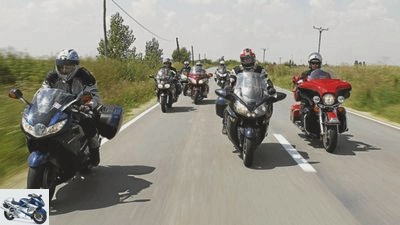
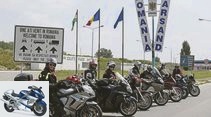
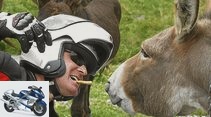
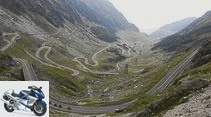
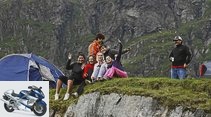
39 photos
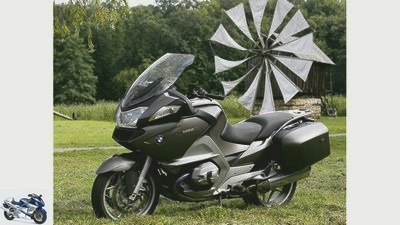
1/39
But now to the tourer bikes. The entry point is the BMW R 1200 RT, which despite its mediocre engine impresses with high-quality equipment, high comfort and a cleverly designed chassis.
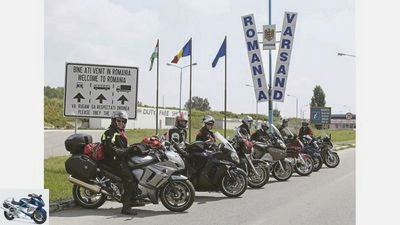
2/39
Finally in Romania the Ministry of Transport welcomes you as a motorcyclist: Vignette only applies to cars. From now on, touring is cheap.
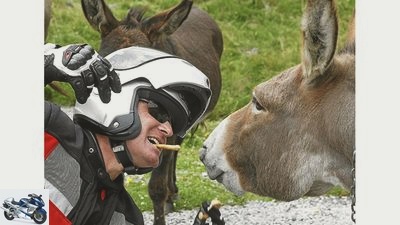
3/39
Not only horses but also donkeys abound here in the wild. The attempt to make friends with them failed. This is also where the riding video with Thomas Schmieder was made.
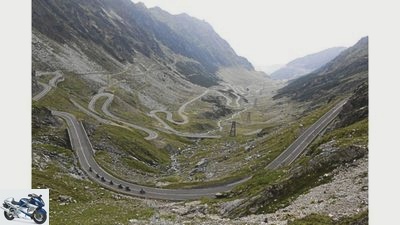
4/39
You can only cross the passes in Romania via a unique maze of curves.

5/39
What you come across more often: Wild camping, which is very common in the Carpathian Mountains. But the campers look forward to every visit to the mountains.
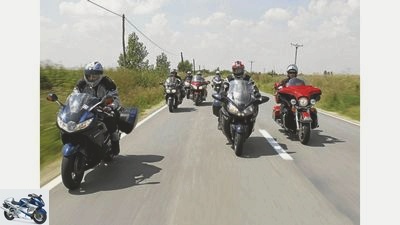
6/39
After 1,500 kilometers through Austria and Hungary, the seven tourers come close to the test area in central Romania.
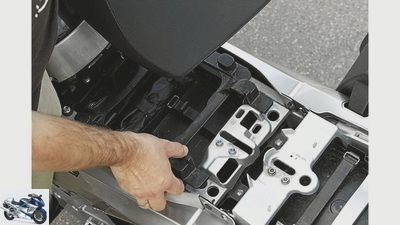
7/39
Practical: By repositioning the holder frame, the comfortable driver’s seat of the Yamaha can be fixed in two stages – 790 or 810 millimeters high.
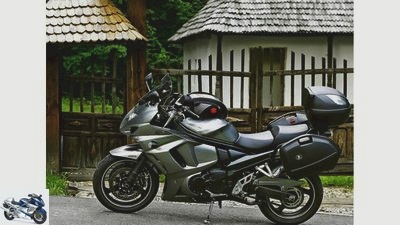
8/39
The Suzuki GSX 1250 FA GT leaves nothing to be desired in everyday life. Their powerful engine also plays a major role in this. The strenuous sitting position, with the resulting lack of comfort, as well as the limited touring equipment, speak against longer tours.
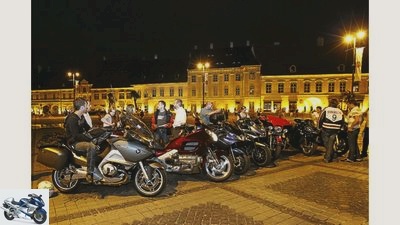
9/39
Finally, a detour to Sibiu, the former capital of Transylvania, is definitely worthwhile. A splendid city where you meet some Germans like in the past. But these are more tourists today.
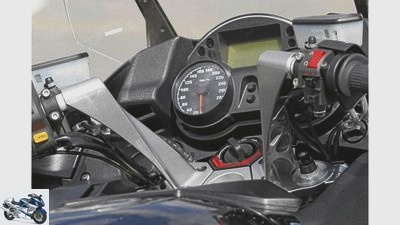
10/39
In the cockpit of the Kawasaki, in addition to the huge key knob, there is also a large transponder for the electronic immobilizer. Another good solution: the rebound damping on the only upside-down fork can be adjusted by hand.
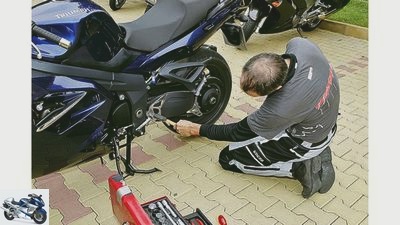
11/39
And although the chain tensioning on the Triumph is easy to do with the eccentric. It’s annoying on tour when everyone else is drinking a beer.
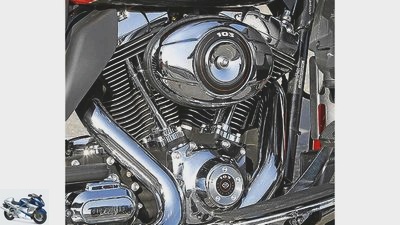
12/39
Unfortunately, the bumper V2 has very little power. On the other hand, the Harley has little load change thanks to the toothed belt for power transmission.
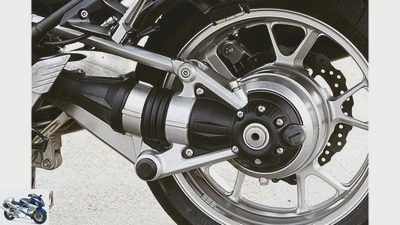
13/39
The Kawasaki lets its drive shaft rotate in a two-arm swing arm. In addition, it has a moment support to reduce undesirable reactions.
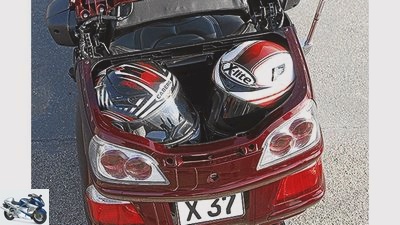
14/39
Loud mouth: The top case of the Gold Wing holds two full-face helmets, the narrow case on the side only holds one open face helmet.

15/39
Elsewhere, the locals are just as friendly. Veronika shows us her huge melons.
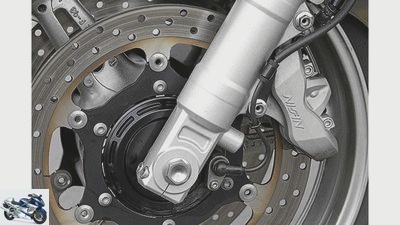
16/39
The Yamaha also helps you brake: all three discs are stimulated to pause when you step on the pedal.
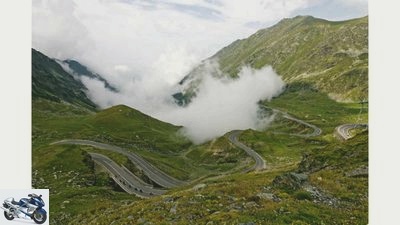
17/39
Fast again over the dreamlike Transfagarasan Pass in the Southern Carpathians, over which a lot of downpour in the first few days unloaded.
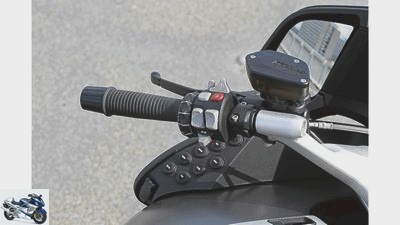
18/39
The little helpers of the BMW R 1200 RT want to be served. This requires the hodgepodge of switches for traction control, target, ESA, etc..
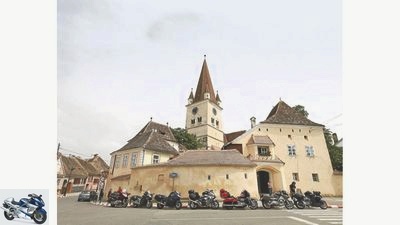
19/39
Once in Transylvania, the visitor will see the landmarks there: defiant church castles like here in Cisnadie (Heltau).
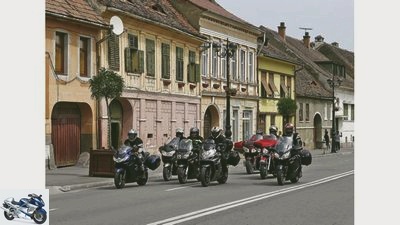
20/39
The contrasts in Romania are also exciting. The picturesque and colorful Cisnadie (Heltau) pleases with its historical flair.
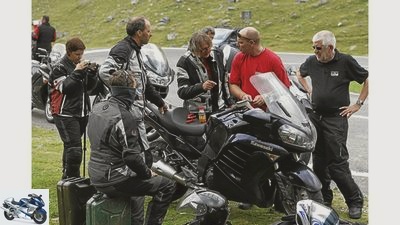
21/39
After the seven bikes have unwound a few kilometers in Romania, the first problems show up: An electronic defect on the Kawasaki 1400 GTR.
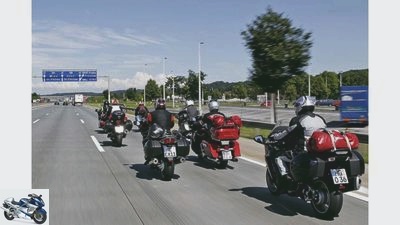
22/39
Since the way to Romania also has to be covered, the first test round led to the highways in the direction of Romania. And it turned out that even stupid mileage is great fun with these tourers.
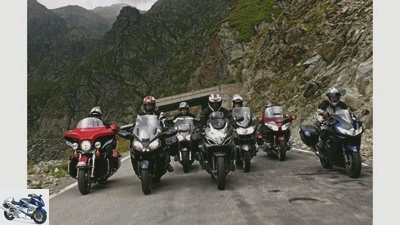
23/39
The Tourer comparison in the realm of Dracula. Although the testers showed no bloodsuckers, the trip through Transylvania had many exciting experiences in store. On the tour, the tourists encountered picturesque villages, untouched nature and imposing mountain formations along the Southern Carpathians.
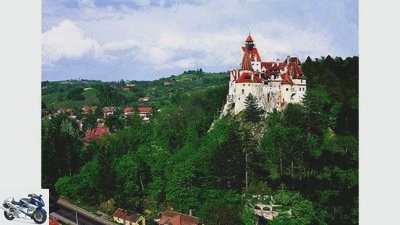
24/39
But the seven tourists were shown other colossal festivals. Bran Castle, the Prince Vlad III. Visited in 1459. The legend that this is Dracula’s domicile comes from this visit.
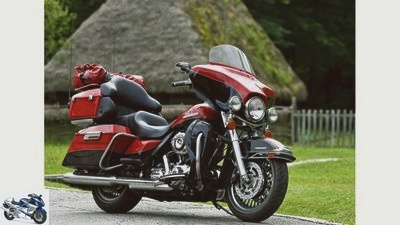
25/39
The US icon: Harley-Davidson Electra Glide Ultra Limited. Running boards and leg protection with luggage compartments exude perfect serenity.
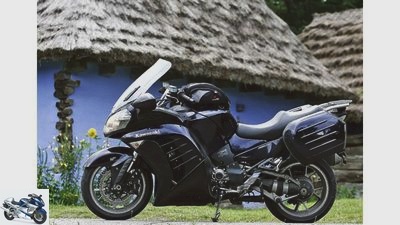
26/39
The Kawasaki 1400 GTR is particularly convincing on the motorway. The windshield and the driver’s seat are convincing, the powerful four-cylinder beams you quickly to the horizon. If only he did that in the lower corridors.
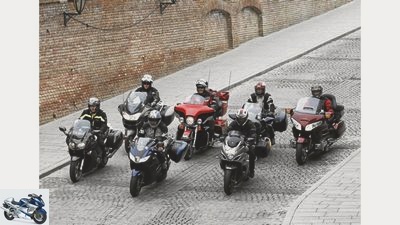
27/39
Inside the Romanian old town, the tourer field gathers to form an imposing picture: seven superlative motorcycles. They combine 839 hp, 909 Newton meters, 2277 kilograms of fighting weight and together cost a mere 136,500 euros.
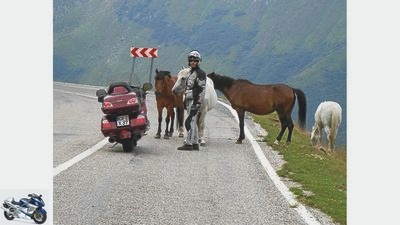
28/39
After the tour group has left the larger cities behind to roll into the mountains, the first locals are already standing across.
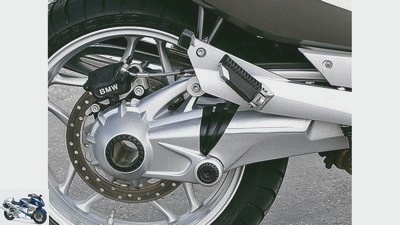
29/39
Easy to care for and therefore very practical on tours: the cardan on the single-sided swing arm at BMW.
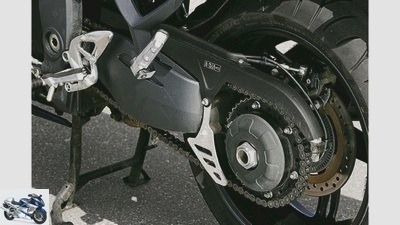
30/39
As with the Suzuki, the chain drive, which requires care, is a minor drawback on longer tours.
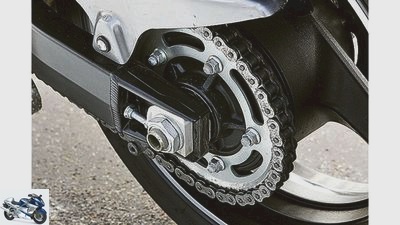
31/39
Another shortcoming on long journeys is the Suzuki chain drive, which requires care.
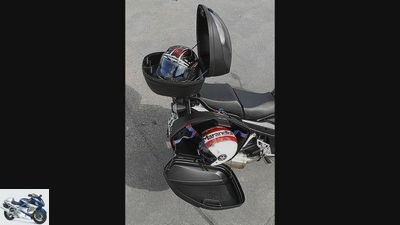
32/39
With a few attachments, however, a lot can be transported with the Suzuki.
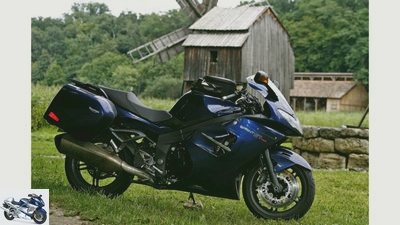
33/39
The Triumph Sprint GT is clearly more touristy than the previous Sprint ST, but also clearly sportier than the rest of the field. For long tours, however, this becomes a problem: moderate wind protection and a stretched sitting position become quite exhausting in the long run.
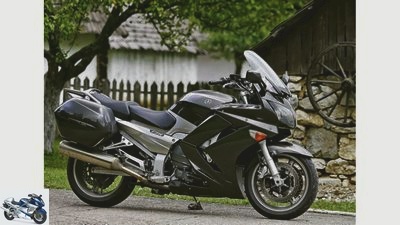
34/39
Timelessly elegant, the Yamaha FJR 1300 A promises dynamism even when it is stationary, which the powerful, unfortunately annoying vibrating engine redeems one-to-one. In addition, there is a high level of touring competence thanks to a comfortable sitting posture and fine details.
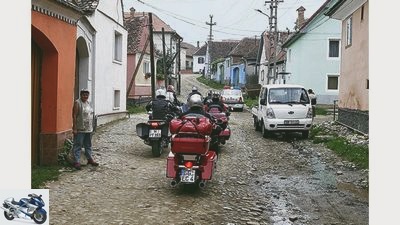
35/39
On the other hand, you can suffer a lot on the rural branch lines that even branch off directly from European roads. Pardon: experience.
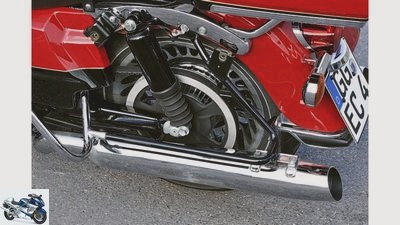
36/39
The tailpipe of the Electra Glide provides the typical Harley sound. It is also practical that the bracket above the exhaust is suitable for mounting large luggage cases.
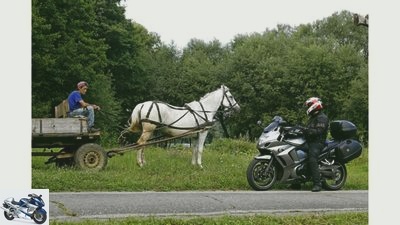
37/39
Similar differences can be seen in the choice of means of transport. Horse-drawn carts are still part of everyday life in Romanian agriculture. On the other hand, our touring cars seem like aliens.
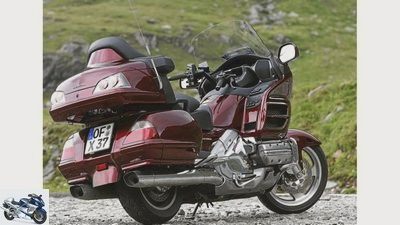
38/39
Some people think that the Honda Gold Wing is no longer a motorcycle, but a car that is missing two wheels. You’re wrong, as great as the perfectly balanced luxury liner swings through the curves. The impressive equipment and the wonderful six-cylinder can be addicting.
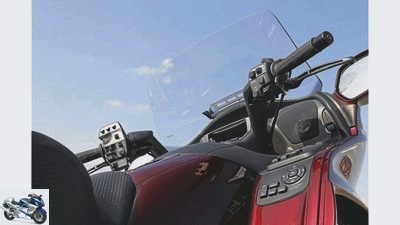
39/39
As in an airplane, the Gold Wing has a total of 52 switches, buttons and controls. On the right in the paneling for the navigation system and on-board compressor.
Comparison test: touring motorcycles – part 2
Seven luxury tourers in comparison
Can you shrink the globe at the push of a button? Yes, in seven ways. These seven tourers bring distant regions closer together. They enable the essence of motorcycle travel: just see what it looks like elsewhere. This is also the case in the second part of the test, over the Transfagarasan Pass from Transylvania to Wallachia.
Comparison test: touring motorcycles
W.he huge gray walls rise the Romanian Southern Carpathians from the lowlands. As if the curtains were wildly nested in a theater. Clear the stage! The Transfagarasan Pass winds its way up into the sky like a corkscrew, from 440 to 2050 meters above sea level. The seven machines pass through dark coniferous forests. A great feeling when such a heavy motorcycle leans from one side to the other under its driver, the full-surface pane in the middle of the field of vision is 45 degrees at an angle.
Buy complete article
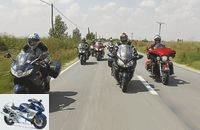
Comparison test: touring motorcycles – part 2
Seven luxury tourers in comparison
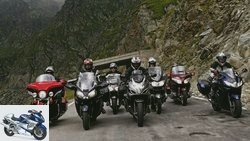
Tourer
Comparison test: touring motorcycles 2010
Seven luxury tourers in comparison
read more
The landscape becomes high alpine, the tree line has been exceeded. Sven Loll, one of the test drivers in the MOTORRAD team, spurs the BMW R 1200 RT on. And how. Relaxed curve enjoyment. After 1500 kilometers of travel to Sibiu (Hermannstadt) and two rainy days, the mountain route looks like a fountain of youth. This huge portion of asphalt spaghetti that leads to Wallachia. A Carrera track for adults. So far, the RT is clearly ahead in the 1000-point rating from the first part of the tourer comparison test (MOTORRAD 19/2010). Now it is primarily about additional tourist aspects: driving behavior fully loaded, equipment, luggage system, braking downhill.
The BMW feels at home in the mountains, willingly and directly following every little steering input. High, wide handlebars meet moderate weight (282 kilograms). The RT makes it really fast without any effort. Although the boxer engine is one of the weaker drives in top tourers, it generates its power in a way that is very road-friendly. Soon BMW and Triumph separate. You feel wonderfully secure behind the bulbous 25 liter RT tank. The Telelever at the front and the Paralever swing arm at the rear feel the road surface sensitively; iron even furrowed stretches of road and hard milled edges on construction sites until they are as smooth as glass – people work hard on the roads in Romania. If the next construction site is lurking around a bend, the BMW driver can use the best brakes in the tourer phalanx.
Sports and touring
The practical thing about such a cruise control? He clears your mind. And the hands. Because there are more important things than steering.
Tester Stefan Gluck fiery storms up the mountains in the Triumph Sprint GT. The smoother the route, the more the Englishwoman is in her element. The three-cylinder pushes beautifully evenly and yet with force, experiencing a second spring at the top. This, the beguiling sound and the best steering precision provide a sensual, sporty driving experience. For better or for worse. In principle, the GT combines a stretched athlete seat position with tourer handling. It would be better the other way around. The elongated GT, for example, requires physical effort in brisk wagging despite the lowest weight.
In terms of tourism, the new Sprint GT is clearly better than the previous ST with its much shorter wheelbase: case much more voluminous, light brighter, passenger seat lower. In addition, their chassis responds more finely. When traveling, the GT only lacks higher handlebar stubs, a better protective screen (available as a Triumph accessory) and a gear indicator. Tribute to the compromise of sports tourers? After all, you should combine the best of both worlds. However, apart from the Triumph and the Honda VFR, there are hardly any more.
The US icon: Harley-Davidson Electra Glide Ultra Limited. Running boards and leg protection with luggage compartments exude perfect serenity.
But a lot of bandits. No, not in the Carpathians, but on the roads of Europe. The bestseller now closes the gap in Suzuki’s tourer range. Ultimately, the GSX 1250 FA is a fully disguised bandit. And the GT version is a fully equipped limited edition of 200 copies – with vario windshield, luggage set and topcase. For a good 10,500 euros by far the cheapest offer. But not the worst. Because how the bearish four-cylinder pushes, that has something. It moves real mountains of torque even in deep speed valleys. So calm, so low-revving, so powerful. Would go well with the brown bears who are supposed to still live here, but don’t show up.
None of the other tourers can follow Suzi carefree while accelerating without downshifting. A bull from an engine. Which you have to grab when the (handlebar) horns are slightly cranked. In the wild back and forth, the insufficient thigh support of the height-adjustable driver’s seat is hardly noticeable. On the way there, however, with its mammoth stages, it had already led to a sore bottom after one or two hours of driving. The pillion seat is also more suitable for short trips. Otherwise, the calmness transfers directly from the machine to the person. It drives almost by itself, the Suzuki, clears your mind for other things. Roughly elevated landscape enjoyment on the visual journey.
Some people think that the Honda Gold Wing is no longer a motorcycle, but a car that is missing two wheels. You’re wrong, as great as the perfectly balanced luxury liner swings through the curves. The impressive equipment and the wonderful six-cylinder can be addicting.
The jagged peaks tower up to a height of 2500 meters. The right environment for the Honda Gold Wing, for a mountain range of a motorcycle. The 1800 with GPS and airbag (!) Weighs a full 421 kilograms. Nevertheless, it can easily be jacked up or balanced again in a vertical position. Above all, however, it rolls much easier than one would expect a half-ton truck, including the driver, to do. Gold swing. Perfectly balanced, blessed with a low center of gravity and a deep seat. Steering precision and feedback are inspiring for such a luxury liner. As if drawn on a ruler, the ship of the line remains stoically stable, even on deep bumps in full incline.
"Kkrrrkk", the Honda pegs are the first to draw furrows in the Transylvanian tar. The 45 mm telescopic fork fulfills its management tasks well; it only appeals a bit stubbornly to impulses that follow one another like cobblestones in turns. The rear central spring strut on the cardan single-sided swing arm offers litter-like comfort. Its spring base can be adjusted to the load at the push of a button using a compressor. This technology does not quite come close to the electronically adjustable chassis of the BMW. Still good. Especially since the six-cylinder boxer runs as smoothly as if its crankshaft were rotating in butter. Loosely and lightly like no other engine in this field, the Sixpack shakes its power out of its sleeve.
One looks far into the valley. After every stop, the super-luxury tourer storms off impetuously. The powerful starting torque, together with the smooth, early-acting hydraulic clutch, quickly sets the 16-inch rear wheel going. For Sozia Michelle, there is hardly anything better on long tours than sitting on the golden swing arm in the heated, super comfortable wing chair. Well protected from the wind and with a good overview. But also "a little passive and far from the action."
Comparison test: touring motorcycles – part 2
The Kawasaki 1400 GTR is particularly convincing on the motorway. The wind protection and the driver’s seat are convincing, the powerful four-cylinder beams you quickly to the horizon. If only he did that in the lower corridors.
The other US bike, the Harley-Davidson Electra Glide Ultra Limited, is even more comfortable to wear. First choice! Honda and Harley, the two cars, remain completely unimpressed by the payload. The RT also takes the pillion up calmly and protects it perfectly from the wind. The pillion sits more upright on the E-Glide, not leaning back as much as on the Gold Wing. Here, too, you can enjoy the widest knee angles and running boards that allow you to vary your leg posture. Good thing because the V2 warms the right foot. "The very own character of the Harley" (Michelle) carries over to the passenger too.
A motorcycle like a monument is the E-Glide. Timeless, classic, stylish. That full "Click" when engaging first gear it sounds like a camera shutter. The bubbling long-stroke hangs softly and elastically on the gas. A pleasure engine whose 71 hp on the rear wheel have to get a good eight hundredweight going. Moderate driving performance requires composure. The Harley exudes like no other. Rainer Froberg takes it easy in the fat saddle. A carriage horse doesn’t turn into a trotting horse. Other questions count on the Harley: How much is 60 degrees Fahrenheit that the thermometer needle shows? 15.5 degrees Celsius. It’s cool at the top of the pass.
See and be seen
The Suzuki GSX 1250 FA GT leaves nothing to be desired in everyday life. Their powerful engine also plays a major role in this. The strenuous sitting position, with the resulting lack of comfort, as well as the limited touring equipment speaks against longer tours.
All other machines are closer to the top. But none is as admired by tourists from half of Europe as the Harley. "The best bike in the world", says a cheeky 17-year-old. Hhmm. She didn’t even look at Kawasaki and Yamaha. Japan’s top tourers don’t deserve that. The FJR 1300, which still looks modern after nine years of construction, makes getting on easy with its moderate width and low seat height. Nevertheless, the knee angle is moderate, the knee joint is full and wide. Mammut stages put you in a good mood on the well-formed seats. For hours, front and back. Jacking up on the main stand is difficult. Even when turning and maneuvering, the 305 kilograms are suddenly collected completely.
In tight turns, the FJR front folds strangely by itself. Fortunately, the north ramp of the Transfagarasan Pass has many wide curves. The yamsel does not stay particularly neutral on wavy sections, hugs its Bridgestone BT 21 "F." the asphalt faults. Correcting is the order of the day. This also applies to the Suzuki GSX 1250 FA GT, on BT 021 "AA". The strong heat radiation of the FJR four-cylinder is only welcome in cool weather. And depending on the height of the windshield, there is quite a bit of turbulence on the FJR between driver and pillion; Vortices plague Michelle’s neck. The shock absorber with two springs offers little choice, "soft" and "hard". It should be more, but less with load changes and vibrations. We wind our way past a crystal clear mountain lake towards the valley, past wild, enthusiastically waving campers. By holding back a little when turning in, the mass of the Kawasaki 1400 GTR will be remembered. 314 kilograms, third place on the heavyweight scale. The Kawa pushes over the front wheel, looks for wide arcs on the 190 rear tire. So use is required on the handlebars, which are soaring as with the FJR. The active, slightly forward-leaning seating position for the driver and front passenger goes well with this.
Kawageworthy. For 1352 cm3 and 155 hp peak power, the GTR throttled in the lower gears pushes out of the corners rather cautiously. It lines up in third gear with a pillion passenger uphill behind Suzuki, BMW and Yamaha. Anyway, we’re going downhill. Dogs, horses and donkeys are suddenly in the bends. There the Kawa has another problem. Extreme fading weakens the brakes. That shouldn’t happen. GTR driver Gabriel Winter turns pale under his helmet. It pours like a bucket, cascades of waterfall cascade down to the valley. To make matters worse, the southern ramp of the Transfagarasan Pass is as one imagines Romanian roads, but they are hardly any more in the northwest: 60 kilometers long, pothole after pothole.
The Triumph Sprint GT is clearly more touristy than the previous Sprint ST, but also clearly sportier than the rest of the field. For long tours, however, this becomes a problem: moderate wind protection and a stretched sitting position become quite exhausting in the long run.
Rumble, a jolt goes through the GTR. Your perfectly coordinated spring elements offer the most reserves after the RT. But when it comes to circles around holes in the tarred surface, which can sometimes accommodate a family of four, the Kawasaki’s handling and feedback should be better. Wetness, fog, zero visibility. Even on the battleship Gold Wing you feel safer, more comfortable than on the two hundredweight lighter Kawasaki. Triumph driver Stefan Gluck enjoys a great feeling for the front wheel. And suffers from a lot of stress on the wrists. The manual clutch force is also a bit high. "Carpathian Tunnel Syndrome" jokes Gabriel.
Daring Wallachia looks here as one imagines Transylvania. We feel our way through dark forests and wild, rugged gorges. Mudslides, scree fields, every section of the route has new surprises in store. The BMW remains completely unimpressed by the slippery road surface. The Metzeler Z6 Interact doesn’t even flinch when you drive over one of the many bitumen strips lengthways.
The Harley embodies the pure opposite. She runs after every longitudinal channel, her Dunlops on the 28-spoke cast wheels find every tiny bitumen stain. Even in dry conditions. If you drive too briskly, the US spacecraft will soon send SOS. The landing gear sways and gushes like a ship in heavy seas. Soft and underdamped, the fork and stereo struts hit through, and quickly come out again. Pumping more air onto the suspension struts, with a full load of up to 3.5 bar, significantly increases their puncture resistance.
When the MOTORBIKE column reached Curtea de Arges, the former capital of Wallachia and the turning point of the tour, the sun was shining. Only the faces get long, the GTR is on strike. Nothing works anymore. No power, no starting, no locking. The microswitch on the ignition lock is not working, so the on-board electronics no longer recognize the immobilizer transmitter (transponder). The next morning, Kawasaki helps over the phone to outsmart the microswitch and revive the on-board electronics. This only works if the transponder is on the vehicle.
Timelessly elegant, the Yamaha FJR 1300 A promises dynamism even when it is stationary, which the powerful, unfortunately annoying vibrating engine redeems one to one. In addition, there is a high level of touring competence thanks to a comfortable sitting position and fine details.
Return trip, farewell. Once again the E-Glide calms you down, makes you relaxed and balanced. The adjustable fins under the wings of your bat cover direct the cooling airstream onto your upper body. After parking, the chrome-plated V2 continues to crackle for hours. If you don’t have much time in life, you should put everything on one card. House, property, everything gone. And ride the E-Glide through Europe for an unforgettable year with the money.
If, on the other hand, you need an almost perfect tourer for small and large escapes from everyday life, you should drive RT. The five other types lie between these extremes: the tried and tested FJR, the powerful GTR, the opulent Gold Wing, the sporty Sprint GT and the inexpensive GSX. This is not only true in Wallachia. Because the end of this journey is the starting point for the next.

Tourer
Comparison test: touring motorcycles 2010
Seven luxury tourers in comparison
read more
Equipment / prices
Features like cars: BMW, Harley and Honda are hardly inferior to mid-range cars. They cost almost as much, offer cruise control, audio systems and connections for MP3 players (BMW) and intercoms from driver to passenger. The Harley sound system from Harman / Kardon spoils you with particularly good sound quality. Plus with surround sound because, unlike BMW and Honda, speakers also sound at the rear. All three have heated grips. Only the Honda has seat heating as standard, with the BMW it is part of the "Touring"-Equipment package. Reverse gear (operated by the starter) and the set of airbag and navigation system (3000 euros surcharge) are only available at the Gold Wing. The equipment from Kawasaki and Yamaha is also of a high standard. Both shine with gear indicators, heated grips and, like the RT, with continuously adjustable discs. On the FJR alone, the handlebar position can be varied in three stages. However, this is a case for the specialist workshop. Only BMW and Kawasaki offer traction control (which can be switched off). The GTR has a tire pressure control as standard, at the RT it costs extra. Cumbersome oil dipsticks on Harley, Triumph and Honda. With the Gold Wing you first have to loosen a plastic cover on the right of the engine. Except for the luggage system, gear indicator and height-adjustable seat, the Suzuki is rather sparsely equipped. It lacks an immobilizer, like the one that the sportier Triumph has. However, it dispenses with hazard warning lights and an adjustable screen, which the GSX 1250 FA GT carries in miniature format.
| BMW R 1200 RT | SECTION |
Standard equipment |
| Case system as standard | Standard equipment | Capacity of the suitcase | 2 x 32 liters |
| Inner pockets (set) | 150 euros | Topcase (content / price) | 49 liters / 495 € |
| One key system | Standard equipment | Luggage rack | Standard equipment |
| Luggage hook | Standard equipment | Storage compartment in paneling | Standard equipment |
| Height-adjustable disc | Standard equipment (electric) | Adjustable seat height | two-stage |
| Adjustable handlebar position | – | Main stand | Standard equipment |
| Width-adjustable brake and clutch levers | Standard equipment / standard equipment | Adjustable spring base at the back | electronic * front / rear |
| Electronically adjustable chassis | 740 euros * | Heated grips / heated seats | 195 * / 205 euros * |
| Second trip odometer | Standard equipment | Consumption display / remaining range | Standard equipment² / standard equipment |
| Fuel gauge | Standard equipment | Tire pressure control | 205 euros * ² |
| Gear indicator | Standard equipment | Oil level indicator | electronic * ² |
| Display of ambient / motor temperature | Standard equipment² / standard equipment | Board socket | 20 Euros* |
| Time clock / hazard warning lights | Standard equipment / standard equipment | Headlight range adjustment |
with handwheel |
| Automatic stability control (ASC) | 300 Euro* | Cruise control / airbag | 310 euros * / – |
| Immobilizer | Standard equipment | Navigation system / reversing aid | 822 euros / – |
| Audio system / prepared connections | 990 € / USB + MP3 |
* included in the Premium Touring Package (1700 euros) or Safety Package (400 euros)
² Only in conjunction with on-board computer for 145 euros.
| Harley-Davidson Electra Glide |
SECTION | Standard equipment |
| Case system as standard | Standard equipment | Capacity of the suitcase | 2 x 27 liters |
| Inner pockets (set) | 360 euros | Topcase (content / price) | 63 liters / standard equipment |
| One key system | Standard equipment | Luggage rack | Standard equipment |
| Luggage hook | Standard equipment | Storage compartment in paneling | Standard equipment |
| Height-adjustable disc | – | Adjustable seat height | – |
| Adjustable handlebar position | – | Main stand | – |
| Width-adjustable brake and clutch levers | Standard equipment / standard equipment | Adjustable spring base at the back | Air with hand pump |
| Electronically adjustable chassis | – | Heated grips / heated seats | Standard equipment / – |
| Second trip odometer | Standard equipment | Consumption display / remaining range | – / standard equipment |
| Fuel gauge | Standard equipment | Tire pressure control | – |
| Gear indicator | – (last only) | Oil level indicator | Dipstick |
| Display of ambient / motor temperature | Standard equipment / standard equipment | Board socket | Standard equipment |
| Time clock / hazard warning lights | Standard equipment / standard equipment | Headlight range adjustment | with tools |
| Automatic stability control (ASC) | – | Cruise control / airbag | Standard equipment / – |
| Immobilizer | Standard equipment | Navigation system / reversing aid | – / – |
| Audio system / prepared connections | Standard equipment / intercom |
| Honda Gold Wing |
SECTION | Standard equipment |
| Case system as standard | Standard equipment | Capacity of the suitcase | 2 x 43 liters |
| Inner pockets (set) | 306 euros | Topcase (content / price) | 61 liters / standard equipment |
| One key system | Standard equipment | Luggage rack | – |
| Luggage hook | – | Storage compartment in paneling | Standard equipment |
| Height-adjustable disc | Standard equipment (mechanical) | Adjustable seat height | – |
| Adjustable handlebar position | – | Main stand | Standard equipment |
| Width-adjustable brake and clutch levers | Standard equipment / standard equipment | Adjustable spring base at the back | Air cushion by on-board compressor |
| Electronically adjustable chassis | – | Heated grips / heated seats | Standard equipment / standard equipment |
| Second trip odometer | Standard equipment | Consumption display / remaining range | – / – |
| Fuel gauge | Standard equipment | Tire pressure control | – |
| Gear indicator | – (last only) | Oil level indicator | Dipstick |
| Display of ambient / motor temperature | Standard equipment / standard equipment | Board socket | – |
| Time clock / hazard warning lights | Standard equipment / standard equipment | Headlight range adjustment | electric |
| Automatic stability control (ASC) | – | Cruise control / airbag | Standard equipment / standard equipment |
| Immobilizer | Standard equipment | Navigation system / reversing aid | Standard equipment / standard equipment |
| Audio system / prepared connections | Standard equipment / intercom |
| Kawasaki 1400 GTR |
SECTION | Standard equipment |
| Case system as standard | Standard equipment | Capacity of the suitcase | 2 x 35 liters |
| Inner pockets (set) | 92 euros | Topcase (content / price) | 28 liters / 295 € |
| One key system | Standard equipment | Luggage rack | Standard equipment |
| Luggage hook | Standard equipment | Storage compartment in paneling | Standard equipment |
| Height-adjustable disc | Standard equipment (electric) | Adjustable seat height | – |
| Adjustable handlebar position | – | Main stand | Standard equipment |
| Width-adjustable brake and clutch levers | Standard equipment / standard equipment | Adjustable spring base at the back | stepless by handwheel |
| Electronically adjustable chassis | – | Heated grips / heated seats | Standard equipment / – |
| Second trip odometer | Standard equipment | Consumption display / remaining range | Standard equipment / standard equipment |
| Fuel gauge | Standard equipment | Tire pressure control | Standard equipment |
| Gear indicator | Standard equipment | Oil level indicator |
Oil sight glass |
| Display of ambient / motor temperature | Standard equipment / standard equipment | Board socket | – |
| Time clock / hazard warning lights | Standard equipment / standard equipment | Headlight range adjustment |
with handwheel |
| Automatic stability control (ASC) | Standard equipment | Cruise control / airbag | – / – |
| Immobilizer | Standard equipment | Navigation system / reversing aid | – / – |
| Audio system / prepared connections | – / – |
| Suzuki GSX 1250 FA GT |
SECTION | Standard equipment |
| Case system as standard | Standard equipment | Capacity of the suitcase | 2 x 33 liters |
| Inner pockets (set) | 144 euros | Topcase (content / price) | 33 liters / standard equipment |
| One key system | – | Luggage rack | Standard equipment |
| Luggage hook | Standard equipment | Storage compartment in paneling | – |
| Height-adjustable disc | Standard equipment (mechanical) | Adjustable seat height | two-stage |
| Adjustable handlebar position | – | Main stand | Standard equipment |
| Width-adjustable brake and clutch levers | Standard equipment / standard equipment | Adjustable spring base at the back | with tool (hook wrench) |
| Electronically adjustable chassis | – | Heated grips / heated seats | – / – |
| Second trip odometer | Standard equipment | Consumption display / remaining range | – / from reserve |
| Fuel gauge | Standard equipment | Tire pressure control | – |
| Gear indicator | Standard equipment | Oil level indicator | Oil sight glass |
| Display of ambient / motor temperature | – / – | Board socket | – |
| Time clock / hazard warning lights | Standard equipment / standard equipment | Headlight range adjustment | with tools |
| Automatic stability control (ASC) | – | Cruise control / airbag | – / – |
| Immobilizer | – | Navigation system / reversing aid | – / – |
| Audio system / prepared connections | – / – |
| Triumph Sprint GT |
SECTION | Standard equipment |
| Case system as standard | Standard equipment | Capacity of the suitcase | 2 x 31 liters |
| Inner pockets (set) | 130 euros | Topcase (content / price) | 55 liters / € 389 |
| One key system | Standard equipment | Luggage rack | Standard equipment |
| Luggage hook | Standard equipment | Storage compartment in paneling | Standard equipment |
| Height-adjustable disc | – | Adjustable seat height | – |
| Adjustable handlebar position | – | Main stand | Standard equipment |
| Width-adjustable brake and clutch levers | Standard equipment / standard equipment | Adjustable spring base at the back | stepless by handwheel |
| Electronically adjustable chassis | – | Heated grips / heated seats | – / – |
| Second trip odometer | Standard equipment | Consumption display / remaining range | Standard equipment / standard equipment |
| Fuel gauge | Standard equipment | Tire pressure control | – |
| Gear indicator | – | Oil level indicator | Dipstick |
| Display of ambient / motor temperature | – / standard equipment | Board socket | Standard equipment |
| Time clock / hazard warning lights | Standard equipment / – | Headlight range adjustment |
with tools |
| Automatic stability control (ASC) | – | Cruise control / airbag | – / – |
| Immobilizer | Standard equipment | Navigation system / reversing aid | – / – |
| Audio system / prepared connections | – / – |
| Yamaha FJR 1300 A |
SECTION | Standard equipment |
| Case system as standard | Standard equipment | Capacity of the suitcase | 2 x 30 liters |
| Inner pockets (set) | 93 euros | Topcase (content / price) | 47 liters / € 255 |
| One key system | Standard equipment | Luggage rack | Standard equipment |
| Luggage hook | Standard equipment | Storage compartment in paneling | Standard equipment |
| Height-adjustable disc | Standard equipment (electric) | Adjustable seat height | two-stage |
| Adjustable handlebar position | Standard equipment | Main stand | Standard equipment |
| Width-adjustable brake and clutch levers | Standard equipment / standard equipment | Adjustable spring base at the back | two-stage |
| Electronically adjustable chassis | – | Heated grips / heated seats | Standard equipment / – |
| Second trip odometer | Standard equipment | Consumption display / remaining range | Standard equipment / from reserve |
| Fuel gauge | Standard equipment | Tire pressure control | – |
| Gear indicator | Standard equipment | Oil level indicator | Oil sight glass |
| Display of ambient / motor temperature | Standard equipment / standard equipment | Board socket | Standard equipment |
| Time clock / hazard warning lights | Standard equipment / standard equipment | Headlight range adjustment | with handwheel |
| Automatic stability control (ASC) | – | Cruise control / airbag | – / – |
| Immobilizer | Standard equipment | Navigation system / reversing aid | – / – |
| Audio system / prepared connections | – / – |
Scoring
Additional rating tourer:
A new rating for long-distance motorcycles. Now they have to show their colors when fully loaded: uphill in third gear from 40 to 80, when braking downhill or the handling in serpentines. All in all, RT and FJR are particularly convincing. With advantages for the BMW, because it is easier to jack up and turn around and enables dream ranges. Points are deducted for the boxer’s oil consumption. When pulling through, the Suzuki depends on the entire field, regardless of the gear. The Honda six-cylinder operates supersmooth, always full speed ahead. The 31,550-euro cracker also leads in terms of equipment. And the E-Glide for the luggage system, it bunkers even more than the non-removable storage space of the Gold Wing. Honda and Harley offer the greatest driving and long-distance seating comfort, followed by GTR and FJR. Touristically beaten: Triumph and Suzuki.
Touring class winner: BMW
1000-point evaluation (details: MOTORRAD 19/2010):
Clear thing? BMW dominates the 1000-point evaluation in MOTORRAD 19/2010 in the chapters chassis, everyday life and safety. But when it comes to the engine it is mediocre, and the ever-fresh FJR is ahead. And the Harley at the cost.
Winner 1000-point classification: BMW
| Max. | BMW | Harley | Honda | Kawasaki | Additional rating tourer | 400 | 324 | 261 | 283 | 268 |
| 1000 point evaluation | 1000 | 731 | 578 | 638 | 692 | Final score | 1400 | 1055 | 839 | 921 | 960 |
| Overall placement | 1. | 5. | 3. | 4th. | Price-performance note | 1.0 | 2.4 | 4.0 | 4.0 | 2.8 |
| Max. |
Suzuki | triumph | Yamaha | |
| Additional rating tourer | 400 | 250 | 247 | 288 | 1000 point evaluation | 1000 | 637 | 669 | 707 |
| Final score | 1400 | 887 | 916 | 995 | Overall placement | 6th. | 7th. | 2. |
| Price-performance note | 1.0 | 1.9 | 2.2 | 2.6 |
Price-performance winner: Suzuki
For a Gold Wing there are three (!) GSX, for an RT there are still almost two 1250 Suzukis. With that all important is said.
Possible payload
Even if it seems so, the Honda Gold Wing doesn’t have the largest payload. The Harley simply has better accommodation options.
The Suzuki GSX 1250 FA GT carries a Givi case system. That is why their luggage compartments are the only ones not painted in the same color as the vehicle. In addition to the ignition key, you also need two keys for the case and topcase. As with Harley and Honda, the latter is standard equipment. Just one size smaller than the competition. Your top loader swallows only one full-face helmet, those of the other two each swallowed two. And the jagged Suzuki suitcase doesn’t even swallow a helmet. This also applies to the two US cars with their narrow suitcases. The E-Glide has parallelogram-shaped suitcases, narrow, long, high, just like the police machines in John F. Kennedy’s time. The lock on the case lid is a bit fiddly. The hinges attached to the side on the Harley topcase are practical, as the lid opens particularly wide. The highlight: the luggage rail on top also holds a large, waterproof luggage roll.
Great, in the end the E-Glide saddles the most. The Gold Wing has the only suitcase that cannot be removed. They are cut deeper at the back than those of the Harley, so at least swallow open face helmets. The three Honda luggage compartments can be opened and locked via radio remote control (!). However, you have to slam the lid firmly, otherwise the multifunction display in the cockpit will complain. It shows which suitcases are still open. The very sturdy and spacious cases from GTR, FJR, RT and Sprint GT are highly functional in practice: easy to open, remove, hang in and carry. In addition, ennobled with inconspicuous carrier systems. The Triumph cases are suspended elastically and can swing around 15 millimeters to the side when connected to one another. This is intended to minimize interference on the chassis. Suzuki, for example, recommends driving a maximum of 130 km / h with the luggage system.
Brake measurement fully loaded
A demanding test on a section of the Romanian Transfagarasan pass that is not too grippy: braking from 100 to zero with a pillion passenger, downhill with a full load, up to well over half a ton. The BMW brakes best. The operation of your partially integral system is also impressive. The hand lever vehemently decelerates both wheels, the pedal only the rear wheel. Useful when turning or when braking to adapt. Completely conventional, completely separate at the front and rear, only Suzuki, Triumph and Harley brake. Quite crisp, the Sprint achieves the second shortest braking distance, it is still ahead of the Yamaha. The Yamaha brakes partially integral: with the hand lever, only the front wheel is optimally metered, with the pedal both wheels.
When anchoring the E-Glide for the first time, you sometimes have to follow up as if there was air in the system. That irritates, even though the Brembo brakes create acceptable braking distances. The GSX stoppers bite a little bluntly, they lack a clear pressure point. Subjectively, the Kawa with its fully integral braking system hits it hard because it always decelerates all three discs. Above all, stepping on the pedal brakes too much at the front (for example in turns). Difficult to dose. But because of the rough ABS control behavior, the braking distances are still poor. In addition, the GTR brake loses a lot of its braking power (fading) under continuous load. The Honda slows down weakly. Little happens when pulling the hand lever alone. It activates three of the six brake pistons at the front and two of the three pistons at the rear via the secondary brake circuit. The pedal controls the remaining three pistons at the front and ultimately all three at the rear.
So if you have to brake hard, please apply both brakes. Or rely on the airbag. Because where the RT is, the Gold Wing rushes through with 36 things. There is an urgent need for improvement here for the nine-year-old braking system.
Brake measurements from 100 km / h:
| medium delay | Braking distance | Residual speed after 45.4 m | BMW | 8.5 m / s² | 45.4 m | 0 km / h |
| triumph | 8.2 m / s² | 47.0 m | 18.5 km / h | Yamaha | 8.1 m / s² | 47.6 m | 21.5 km / h |
| Harley | 7.9 m / s² | 48.8 m | 26.4 km / h | Suzuki | 7.8 m / s² | 49.5 m | 28.8 km / h |
| Kawasaki | 7.5 m / s² | 51.4 m | 34.2 km / h | Honda | 7.4 m / s² | 52.1 m | 35.9 km / h |

Tourer
Comparison test: touring motorcycles 2010
Seven luxury tourers in comparison
read more
Range and consumption
If the Suzuki rolls empty to the tank after an average of 306 kilometers, the BMW will still manage almost 200 kilometers.
Refueling depresses the travel cuts and leads to stops at mostly ugly places. This is particularly annoying with the Suzuki with its small 19 liter tank. On country roads with a speed limit, relevant for the 1000 point rating, it needs 5.8 liters per 100 kilometers, which gives a range of 328 kilometers. The tour consumption, which is evaluated here, includes motorway stages, as well as pass journeys with full luggage. Moved like this, the GSX needs 6.2 liters, can still manage 306 kilometers. And already flashes 70, 80 kilometers beforehand "reserve". With the same consumption, the Yamaha with a 25-liter tank can travel exactly 97 kilometers. The Kawasaki and especially the Honda are thirstier than the Suzuki, but they have a slightly larger radius of action due to their larger fuel barrels. The Harley doesn’t use much for a rolling wall unit. Triumph and BMW are really economical with around five liters, but the RT bunkers five liters more.
Range and consumption:
| Tank capacity / reserve | medium consumption | Range | Remaining range after 306 km | Suzuki | 19/0 liters | 6.2 liters / normal | 306 km | 0 km |
| Kawasaki | 22/0 liters | 6.5 liters / normal | 338 km | 32 km | Honda | 25/0 liters | 6.8 liters / super | 367 km | 61 km |
| Harley | 23/4 liters | 5.9 liters / super | 389 km | 83 km | triumph | 20/0 liters | 5.1 liters / super | 392 km | 86 km |
| Yamaha | 25/0 liters | 6.2 liters / normal | 403 km | 97 km | BMW | 25/4 liters | 5.0 liters / Super Plus | 500 km | 194 km |
Overall result
Finally in Romania the Ministry of Transport welcomes you as a motorcyclist: Vignette only applies to cars. From now on, touring is cheap.
1st place: BMW R 1200 RT
BMW traditionally does its homework particularly well in the touring sector. And so the cleverly designed RT wins both ratings despite mediocre engine performance. Equipment, chassis, comfort, everything is great. If you don’t believe it, you should just test drive it.
2nd place: Yamaha FJR 1300 A
It is not without reason that the FJR has gathered so many fans around it since 2001. Timelessly elegant, it already promises dynamism when stationary, which the powerful, unfortunately annoying vibrating engine redeems one-to-one. In addition, there is a high level of touring competence thanks to a comfortable sitting posture and fine details.
3rd place: Kawasaki 1400 GTR
The sumo wrestler is heavy and also a bit clumsy. But there is hardly anything better on long stretches of the motorway: the windshield and driver’s seat are convincing, the powerful four-cylinder beam quickly to the horizon. If only he did that in the lower corridors…
4th place: Triumph Sprint GT
More touristy than the previous Sprint ST, clearly sportier than the rest of the field, this is how the GT’s niche is outlined. The high accuracy and the elastic three-cylinder, which demands a little more speed, are sporty. However, also the stretched sitting position and the moderate wind protection.
5th place: Honda Gold Wing
Some people think that the Gold Wing is not a motorcycle at all, but a car that is missing two wheels. You’re wrong, as great as the perfectly balanced luxury liner swings through the curves. The impressive equipment and the wonderful six-cylinder can be addicting.
6th place: Suzuki GSX 1250 FA GT
The GSX drives balanced in everyday life. The powerful, beefy four-cylinder leaves nothing to be desired on tour. All of this is available at an absolute dumping price. Suzuki should only improve seating comfort. And think about whether 200 copies of the GT version are not a bit small.
7th place: Harley-Davidson Electra Glide Ultra Ltd.
Sound and feeling. A great tourer, with extremely comfortable seats and lots of storage space. Moderate performance and a soft, comfort-oriented chassis even fit the concept. Drive slowly, feel the V2 heartbeat, see a lot. First place for experience value!

Tourer
Comparison test: touring motorcycles 2010
Seven luxury tourers in comparison
read more
Related articles
-
Comparison test travel enduro: Sweden to the North Cape
Jahn 28 photos Jahn 1/28 The operation of the Multistrada has also changed: a control center for electronics and motor directly on the handlebars. Jahn…
-
Comparison test: touring motorcycles
fact 39 pictures fact 1/39 But now to the tourer bikes. The entry-level is the BMW R 1200 RT, which despite its mediocre engine with high-quality equipment, …
-
48 hp motorcycles in a comparison test
Bilski 71 photos Bilski 1/71 Seven 48 hp twins from the manufacturers Honda, Ducati, Suzuki, Harley-Davidson, Kawasaki and BMW were tested. Bilski 2/71…
-
BMW F 800 GS and Triumph Tiger 800 XCx in comparison test
fact 37 photos fact 1/37 Triumph Tiger 800 XCx. triumph 2/37 Not a bargain, but a two plus proves: The Triumph Tiger 800 XCx offers a lot of technology…
-
Honda GL 1800 Gold Wing Tour DCT airbag 2018 touring test
bilski-fotografie.de 21st photos bilski-fotografie.de 1/21 Honda GL 1800 Gold Wing Tour DCT / Airbag in the touring test. bilski-fotografie.de 2/21…
-
Concept comparison travel motorcycles
Concept comparison travel motorcycles Four make the bend Not because of a »crooked tour«: The point here is to find the right travel companion. Sure -…
-
Comparison test of cheap entry-level motorcycles from Europe
fact Comparison test of cheap entry-level motorcycles from Europe EUROPEAN ELECTION These people’s representatives come from the core countries of the…
-
Comparison test touring enduro bikes: Honda Transalp, Kawasaki Versys, Suzuki V-Strom 650
Jahn Comparison test of travel enduro bikes: Honda Transalp, Kawasaki Versys, Suzuki V-Strom 650 Always along the wall Travel enduro doesn’t necessarily…
-
Comparison test: the strongest touring athletes
Fact Comparison test: The strongest touring athletes (with video) Test: Sporty bikes with long-distance ambitions Content of They are significantly…
-
Comparison test of the 1000 super sports car, part 1
Jahn Comparison test of the 1000 super sports car, part 1 The full program Lean, strong, ready for attack, the Suzuki GSX-R 1000 completes the field of…